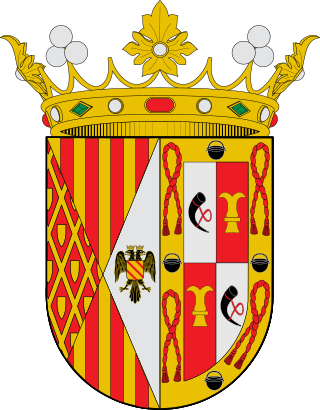Related Research Articles

Íñigo López de Mendoza, 1st Marquess of Santillana was a Castilian politician and poet who held an important position in society and literature during the reign of John II of Castile.

The Archdiocese of Toledo is a Latin Church archdiocese of the Catholic Church located in Spain. They are also the Primates of Spain. It was, according to tradition established in the 1st century by James the Great and was elevated to an archdiocese in 313 after the Edict of Milan. The incumbent Metropolitan Archbishop also bears the title Primate of Spain and since 1937 the title General Vicar of the Armies

The Marquis of Cañete is a Spanish nobility title and Grandee of Spain. The title was created by the Catholic Monarchs in 1490 and given to Juan Hurtado de Mendoza, 3rd Lord of Cañete.
The Sicilian title Duke of Bivona stems from the middle 16th century. Bivona is in Sicily, which had been conquered by Peter III of Aragon in 1282. It was given to people related to the powerful medieval Aragonese family of Luna, Zaragoza.

Juan Tomás Enríquez de Cabrera y Ponce de Leon, VII Duque de Medina de Río-Seco, was a Spanish noble and military leader.

Juan Francisco Pimentel, 7th Duke of Benavente also known as Juan Francisco Alonso Pimentel y Ponce de León was a seventeenth-century Spanish noble, a Knight of the Order of the Golden Fleece in 1648, number 421, 10th Count and 7th Duke of Benavente, 10th Count of Mayorga, 8th Count of Comarca de Luna.
The Caballerizo mayor was the Officer of the Royal Household and Heritage of the Crown of Spain in charge of the trips, the mews, and the hunt of the King of Spain.
The Mayordomo mayor was the Officer of the Royal Household and Heritage of the Crown of Spain in charge of the person and rooms of the King of Spain. The Office of “Mayordomo mayor” was suppressed after the proclamation of the Second Spanish Republic in 1931 and never re-created after the restoration of the Monarchy in 1975, but it can be said that it is the historical precedent of the modern Head of the Royal Household of Spain.
Alfonso de Aragón y Portugal, or Alfonso I de Ampurias, was Count of Ampurias and Duke of Segorbe.
The Spanish Royal Statute of 1834 established a bicameral legislature (Cortes) consisting of an upper chamber of unelected nobles and a lower chamber of elected representatives. The first session was opened on 24 July 1834 and closed on 29 May 1835.

Marquess of Priego is a hereditary noble title of the Kingdom of Spain that Ferdinand the Catholic granted on 9 December 1501 to Pedro Fernández de Córdoba y Pacheco, 7th Lord of Aguilar in Córdoba, of the house of Córdoba. It is one of the most important noble titles in Spain, and was made a first class grandee in 1520 by Charles V, Holy Roman Emperor.

Duke of Montalto was a hereditary title in the Peerage of Spain, accompanied by the dignity of Grandee and granted in 1507 by Ferdinand II to his nephew Fernando de Aragón y Guardato, who was an illegitimate son of Ferdinand I of Naples.

Marquess of Terranova, is a title of Spanish nobility. It was granted along with the Dukedom of Mandas to Pedro Maza de Lizana on 23 December 1614 by king Philip III.

Count of Villaverde de Madrid, commonly known as Count of Villaverde is a hereditary title in the Peerage of Spain, granted in 1602 by Philip III to Lope de Guzmán y Portocarrero.
References
This article needs additional citations for verification .(August 2007) |